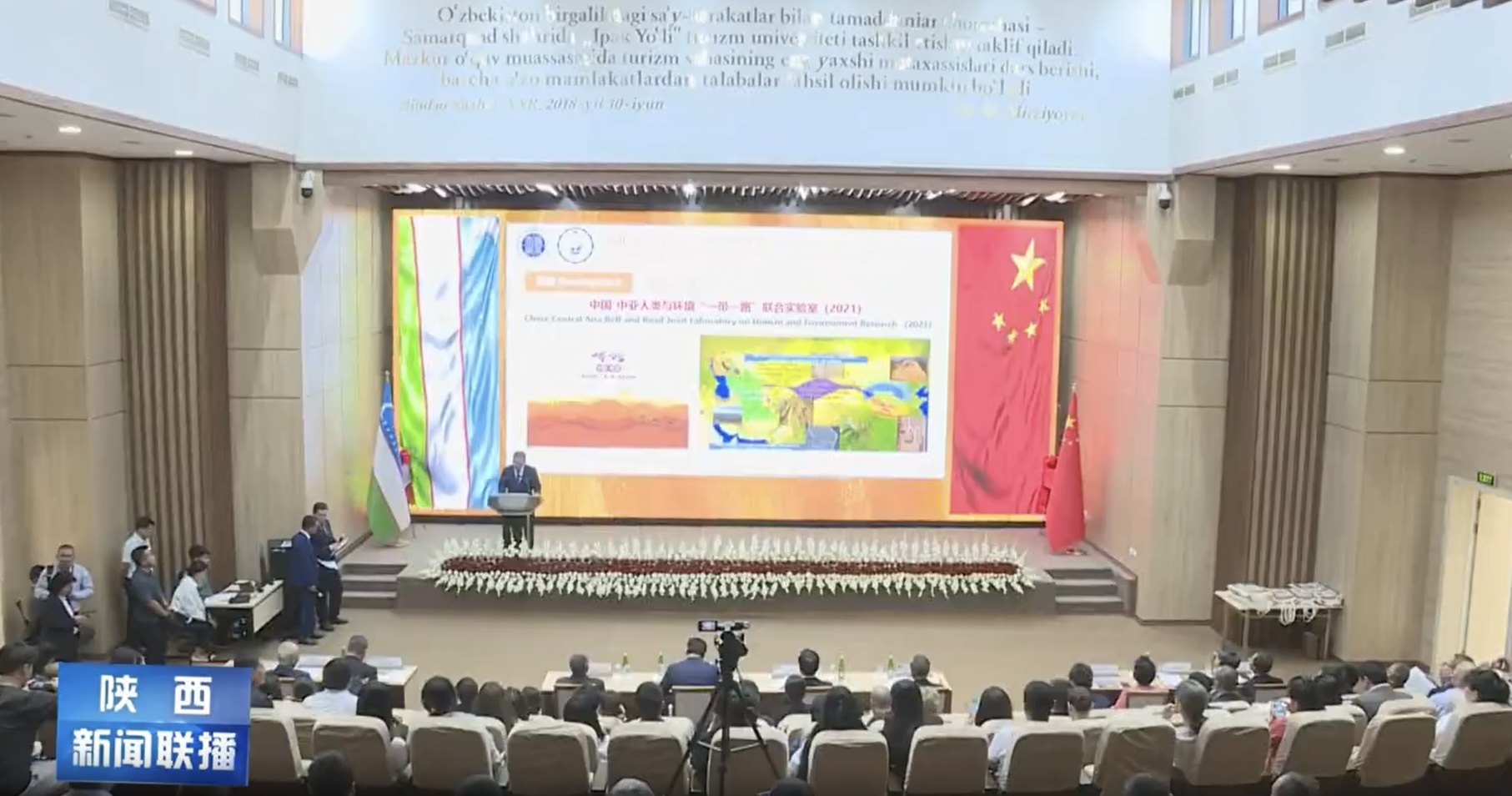On September 2, during his visit to Uzbekistan, Zhao Yide, Secretary of the Shaanxi Provincial Party Committee and Director of the Standing Committee of the Provincial People’s Congress, led a delegation to visit the work site of the Central Asian archaeological team of Northwest University and unveiled the China-Central Asia Joint Laboratory of Humanity and the Environment on “One Belt and One Road” (Samarkand), and the China-Uzbekistan International Joint Laboratory of Scientific and Technological Archaeology and Cultural Heritage Protection, which were jointly established by the University and the Silk Road International University of Tourism and Cultural Heritage.
At 10:30 a.m., Zhao Yide and his delegation arrived at the Samarkand Institute of Archaeology and paid condolences to the teachers and graduate students of NWU who were on the spot to organize the archaeological excavation data of Rabat and Serharakat sites in Surkhandarya Oblast of Uzbekistan. The former director of the Samarkand Institute of Archaeology, Amuruddin, and the current director, Mu Minghan, introduced the process and achievements of their joint archaeological work with the Central Asian Archaeological Team of NWU. Afterwards, accompanied by Prof. Wang Jianxin, Chief Scientist of Collaborative Research Center for Archaeology of the Silk Roads, Zhao Yide and his delegation visited the photo exhibition and unearthed artifacts of Sino-Uzbekistan joint archaeological achievements of NWU and listened to the relevant work report. During the visit, Zhao Yide highly affirmed the achievements of Central Asian archaeology of NWU.
At 11:30 a.m., Zhao Yide and Abdulhakimov, Minister of Ecology, Environmental Protection and Climate Change of Uzbekistan, jointly inaugurated the China-Central Asia Joint Laboratory of Humanity and the Environment on “One Belt and One Road” (Samarkand) and the China-Uzbekistan International Joint Laboratory of Scientific and Technological Archaeology and Cultural Heritage Protection. Jia Qiang, deputy director of Shaanxi Provincial Bureau of Cultural Relics, Chang Jiang,vice president of NWU, Rustam Rajaboevich Kobilov, deputy governor of Samarkand, and Zou Tongqian, vice president of Silk Road University, unveiled the plaques together.
Zhao Yide mentioned in his speech that the establishment of a joint laboratory between Northwest University and the Silk Road International University of Tourism and Cultural Heritage of Uzbekistan is a concrete action to implement the results of the China-Central Asian Summit, and another vivid practice of cooperation between Shaanxi and Uzbekistan, which will surely promote the two universities to make more progress in talent cultivation, scientific research, and disciplinary construction and make greater contributions to the high-quality development of the “One Belt, One Road” Initiative. It is hoped that the two sides will work closely together and strive to make the joint laboratory a first-class research platform for international scientific and technological cooperation and an important bridge for promoting people-to-people exchanges, so that the tree of China-Uzbekistan friendship will be more deeply rooted and flourish.
At the inauguration ceremony, Chang Jiang made a report entitled “Integration of Science, Technology and Culture, Exchange and Mutual Appreciation of Civilizations, Advancing China-Uzbekistan Cooperation and Exchanges to a New Level”, and exchanged gifts with Abdulhachimov Aziz Abdulkaharovich, President of the Silk Road International University of Tourism and Cultural Heritage, on behalf of the two universities.
The Chinese Embassy in Uzbekistan sent a congratulatory letter on the successful inauguration of the China-Central Asia Joint Laboratory of Humanity and the Environment on “One Belt and One Road” (Samarkand) and the China-Uzbekistan International Joint Laboratory of Scientific and Technological Archaeology and Cultural Heritage Protection, and expressed the hope that the two sides, relying on the high-level research platforms of the Joint Laboratory, would actively conduct scientific research in the field of archaeology, and make new contributions to the restoration of the historical appearance of the Silk Road, the promotion of the inheritance of civilizations and exchanges of ideas and mutual understanding, as well as the enhancement of the friendship of the peoples of China and Uzbekistan.
The “Belt and Road” Joint Laboratory is a top-level platform for foreign scientific and technological cooperation and innovation approved by the Ministry of Science and Technology of China and modeled after the National Key Laboratory. The China-Central Asia Joint Laboratory of Humanity and the Environment on “One Belt and One Road” (Samarkand) (hereinafter referred to as the “Joint Laboratory”) is built by NWU in cooperation with universities and scientific research institutions in Central Asian countries, such as Uzbekistan and Tajikistan and is the sole “One Belt and One Road” national key laboratory in Shaanxi Province.In order to make the Joint Laboratory a high-level research platform for international scientific and technological cooperation, NWU has taken the construction standards of national laboratories as reference, and built a grid of connected joint laboratories in the relevant provinces of China and the five Central Asian countries. And, on this basis, deepen the cooperation with universities and scientific research institutes in the provinces and states (cities), and set up inter-institutional joint sub-laboratories as a branch of the research bases.
The inauguration of the China-Central Asia Joint Laboratory of Humanity and the Environment on “One Belt and One Road” (Samarkand) is the first research base set up in Central Asia, and the China-Uzbekistan International Joint Laboratory of Scientific and Technological Archaeology and Cultural Heritage Protection jointly established by NWU and Silk Road University is an important part of the research base, and in the future, on the basis of deepening the existing cooperation, exploring a new sense of cooperation, and continuing to promote the laboratory of high level and high quality development, and the output of the results of the cooperation has an international impact, and to make positive contributions to the promotion of the country’s humanistic exchanges and people-to-people exchanges of the countries of the “Belt and Road”.







